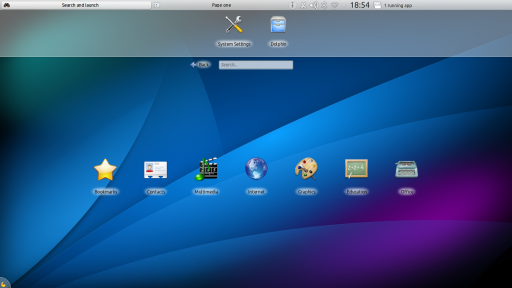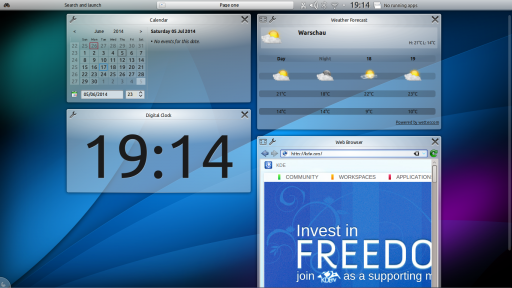Plasma/Netbooks/en: Difference between revisions
Updating to match new version of source page |
Updating to match new version of source page |
||
| (2 intermediate revisions by the same user not shown) | |||
| Line 3: | Line 3: | ||
KDE's Plasma Netbook is a workspace made specifically for small, lightweight netbook devices. | KDE's Plasma Netbook is a workspace made specifically for small, lightweight netbook devices. | ||
[[Image:s&l_plasma_netbook.png|512px|thumb|center|Plasma Netbook - Search and launch]] | |||
==Features== | ==Features== | ||
| Line 14: | Line 16: | ||
==Requirements== | ==Requirements== | ||
Plasma Netbook requires 3D acceleration to function properly. It is | Plasma Netbook requires 3D acceleration to function properly. It is therefore not advisable to try it in a non-compositing environment. In human language, this means: you need a 3D capable system with the right configuration. Most modern systems (including pretty much all netbooks) comply to this, but some 3D video cards, especially those depending on proprietary drivers (ATI, NVIDIA) sometimes do not. | ||
==How to enable it== | ==How to enable it== | ||
To enable the Netbook interface, go to <menuchoice>System settings</menuchoice>, choose <menuchoice> | To enable the Netbook interface, go to <menuchoice>System settings</menuchoice>, choose <menuchoice>Workspace Behavior</menuchoice>, choose <menuchoice>Workspace</menuchoice> and under <menuchoice>Workspace Type</menuchoice> choose <menuchoice>Netbook</menuchoice>. | ||
==Tips and Tricks== | ==Tips and Tricks== | ||
| Line 30: | Line 32: | ||
* use the probably familiar <keycap>Alt + Tab</keycap> shortcut | * use the probably familiar <keycap>Alt + Tab</keycap> shortcut | ||
* go to the top-left of the screen with your mouse and bump into the corner. All windows will show up, scaled, on your screen. Choose one with the mouse or type (part of) a name and hit | * go to the top-left of the screen with your mouse and bump into the corner. All windows will show up, scaled, on your screen. Choose one with the mouse or type (part of) a name and hit <keycap>Enter</keycap>. | ||
===Taskbar or panel=== | ===Taskbar or panel=== | ||
| Line 37: | Line 39: | ||
====Closing or changing windows==== | ====Closing or changing windows==== | ||
[[Image:tasks_plasma_netbook.png|512px|thumb|center|View Running Tasks]] | |||
On the right of the top panel is a close button which will close your current window. If you click on the field to the left of it showing the icon and name of the currently displayed application (or "X running tasks" if the current window is the start page), you will see all running tasks scaled on the screen (like when you push with your mouse in the top-left corner of the screen). | On the right of the top panel is a close button which will close your current window. If you click on the field to the left of it showing the icon and name of the currently displayed application (or "X running tasks" if the current window is the start page), you will see all running tasks scaled on the screen (like when you push with your mouse in the top-left corner of the screen). | ||
| Line 49: | Line 53: | ||
====Pages==== | ====Pages==== | ||
[[Image:page_plasma_netbook.png|512px|thumb|center|Plasma Netbook - Page]] | |||
Next to the app launcher you have your first 'page'. Each page has one or more rows of widgets, small applications. These can be used to quickly show you news, view upcoming appointments, control your music player or even browse a webpage. | Next to the app launcher you have your first 'page'. Each page has one or more rows of widgets, small applications. These can be used to quickly show you news, view upcoming appointments, control your music player or even browse a webpage. | ||
| Line 54: | Line 60: | ||
=====Add widgets===== | =====Add widgets===== | ||
Click on the Plasma logo {{Icon|plasma}} on the bottom of the page. A configuration bar will pop up. Unlock | Click on the Plasma logo {{Icon|plasma}} on the bottom of the page. A configuration bar will pop up. Click <menuchoice>Unlock Page</menuchoice> (if it is locked), and you will be able to add widgets (click <menuchoice>Add Widgets</menuchoice> and drag and drop the widgets to the desired location) or add more pages. You can also click <menuchoice>Configure Page</menuchoice> to give your page a proper name, a new background et cetera. | ||
=====Add a page===== | =====Add a page===== | ||
Click on the Plasma logo {{Icon|plasma}} on the bottom of the page. A configuration bar will pop up. | Click on the Plasma logo {{Icon|plasma}} on the bottom of the page. A configuration bar will pop up. Click <menuchoice>Add page</menuchoice> to add a page. | ||
=====Configure the page===== | =====Configure the page===== | ||
Click on the Plasma logo {{Icon|plasma}} on the bottom of the page. A configuration bar will pop up. Unlock the | [[Image:Configure_page_plasma_netbook.png|512px|thumb|center|Configuration Bar]] | ||
Click on the Plasma logo {{Icon|plasma}} on the bottom of the page. A configuration bar will pop up. Click <menuchoice>Unlock Page</menuchoice> if the page is locked, and you will be able to configure the page. You can now give it a background, a name, and more. | |||
[[Category:Plasma]] | [[Category:Plasma]] | ||
Latest revision as of 20:14, 17 June 2014
Full KDE on Small Screens (e.g. Netbooks)
KDE's Plasma Netbook is a workspace made specifically for small, lightweight netbook devices.

Features
- Search and run applications easily
- Rich Internet experience
- Organizing your space more efficient
Requirements
Plasma Netbook requires 3D acceleration to function properly. It is therefore not advisable to try it in a non-compositing environment. In human language, this means: you need a 3D capable system with the right configuration. Most modern systems (including pretty much all netbooks) comply to this, but some 3D video cards, especially those depending on proprietary drivers (ATI, NVIDIA) sometimes do not.
How to enable it
To enable the Netbook interface, go to , choose , choose and under choose .
Tips and Tricks
Сhanging tasks
Windows will be fully maximized, without taskbar(s) or window decoration (window title & buttons to close/minimize etc) visible.
To change tasks you can do two things:
- use the probably familiar Alt + Tab shortcut
- go to the top-left of the screen with your mouse and bump into the corner. All windows will show up, scaled, on your screen. Choose one with the mouse or type (part of) a name and hit Enter.
Taskbar or panel
There is a hidden panel on the top of your screen. If you bump your mouse against the top of your screen, it will become visible.
Closing or changing windows

On the right of the top panel is a close button which will close your current window. If you click on the field to the left of it showing the icon and name of the currently displayed application (or "X running tasks" if the current window is the start page), you will see all running tasks scaled on the screen (like when you push with your mouse in the top-left corner of the screen).
System Tray
Left to the button showing the current application is the system tray with icons showing network connection and battery life.
Launching apps
Next to the system tray, to the left of the panel, are buttons to go to the application launcher or to the pages you have defined. Click on the launcher and you can start applications by clicking the categories or using the search.
Pages

Next to the app launcher you have your first 'page'. Each page has one or more rows of widgets, small applications. These can be used to quickly show you news, view upcoming appointments, control your music player or even browse a webpage.
Add widgets
Click on the Plasma logo ![]() on the bottom of the page. A configuration bar will pop up. Click (if it is locked), and you will be able to add widgets (click and drag and drop the widgets to the desired location) or add more pages. You can also click to give your page a proper name, a new background et cetera.
on the bottom of the page. A configuration bar will pop up. Click (if it is locked), and you will be able to add widgets (click and drag and drop the widgets to the desired location) or add more pages. You can also click to give your page a proper name, a new background et cetera.
Add a page
Click on the Plasma logo ![]() on the bottom of the page. A configuration bar will pop up. Click to add a page.
on the bottom of the page. A configuration bar will pop up. Click to add a page.
Configure the page

Click on the Plasma logo ![]() on the bottom of the page. A configuration bar will pop up. Click if the page is locked, and you will be able to configure the page. You can now give it a background, a name, and more.
on the bottom of the page. A configuration bar will pop up. Click if the page is locked, and you will be able to configure the page. You can now give it a background, a name, and more.
